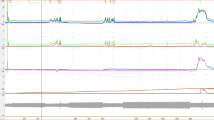Summary
Using a bladder-urethra model, 2 perfusion catheters (open side and open tip) were compared to the balloon catheter. The most accurate results were obtained using the balloon catheter. Based on the law of continuity and Bernouilli's law, the disadvantage of the open side catheter is due to the inconstant diameter of the sum of the side holes. Therefore, the measured pressure is not necessarily identical to the real pressure. The open tip catheter measures the opening pressure and the recorded pressure does not necessarily reflect the pressure at the site of the tip hole. The balloon catheter has elastic and plastic characteristics. Optimum results were obtained only with prestretch of the balloon and with calibration before and after each study. This catheter was the most complicated, but produced the best results and gave rise to the least irritation.
Similar content being viewed by others
References
Beck, L., Heidenreich, J.: Simultane Druckmessung in der Harnröhre und Harnblase zur Diagnostik der Harninkontinenz. Archiv für Gynaekologie 211, 325 (1971)
Brown, M., Wickham, J. E. A.: The urethral pressure profile. British Journal of Urology 41, 211 (1969)
Drouin, G., McCurry, E. M.: Catheters for studies of urinary tract pressure. Investigative Urology 8, 195 (1970)
Eck, B.: Technische Strömungslehre. 7. Aufl. Berlin, Heidelberg, New York: Springer 1966
Enhörning, G.: Simultaneous recording of intravesical and intraurethral pressure. Acta Chirurgica Scandinavica Suppl. 276 (1961)
Jonas, U., Klotter, H. J.: Comparative study of the urinary tract pressure recording using 3 different techniques: an experimental study and its clinical analysis. 5th Annual Conference of the International Continence Society; Glasgow 1975
Klotter, H. J.: Experimentelle Cysto-Urethra-Manometrie: eine Modellbetrachtung der 3 gängigsten Druckmeßverfahren. Dissertation, Urologische Univ. Klinik, Mainz 1976
Kunath, U., Schier, G.: Was sagt die Durchzugsperfusionsmanometrie über die Druckverhältnisse im Verschlußsegment der Speiseröhre aus? Deutsche Medizinische Wochenschrift 99, 1991 (1974)
Tanagho, E. A., Jonas, U.: Membrane catheter: effective for recording pressure in lower urinary tract. Urology, 10, 173 (1977)
Waldeck, F., Jennewein, H. M., Graubner, P.: Methodische Untersuchungen zur Druckmessung im Oesophagus. Leber Magen Darm 2, 14 (1972)
Author information
Authors and Affiliations
Rights and permissions
About this article
Cite this article
Jonas, U., Klotter, H.J. Study of three urethral pressure recording devices: Theoretical considerations. Urol. Res. 6, 119–125 (1978). https://doi.org/10.1007/BF00261311
Accepted:
Issue Date:
DOI: https://doi.org/10.1007/BF00261311




